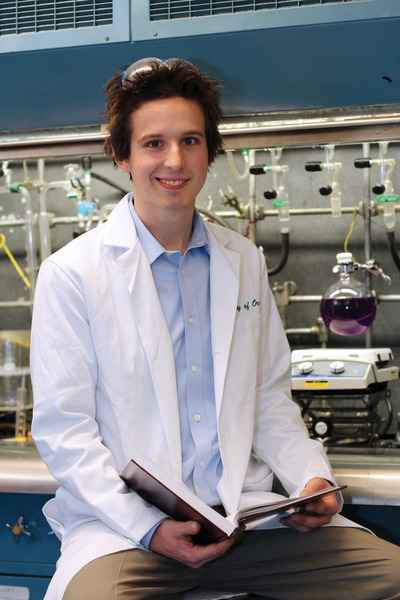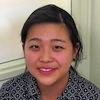Gregory Harlow thought his future was set: Finish his chemistry studies at the UO. Get a pharmacist’s degree. Find a job in retail pharmacy—Target, maybe.
Not too exciting, perhaps, but what else was there for a guy who gets fired up about molecules, carbon-based compounds and nitrogen-boron ring systems?
Enter: Shih-Yuan Liu’s organic chemistry class.
Liu encourages students to “go beyond the textbook,” to ask their own questions and find answers in whatever resources are available, including scientific journals and articles. It was Harlow’s first taste of true research, and it awakened something within him.
“I found myself spending my free time reading about chemistry beyond the scope of the class—just out of curiosity,” Harlow said. “It opened me up to the whole scientific process. It required me to think.”
 That was March 2011, when Harlow (right) was a junior. In the twenty months since, Harlow has joined Liu’s laboratory, landed a prestigious scholarship, contributed research that will appear in two published papers and scratched the pharmacy career path in favor of pursuing a PhD in chemistry.
That was March 2011, when Harlow (right) was a junior. In the twenty months since, Harlow has joined Liu’s laboratory, landed a prestigious scholarship, contributed research that will appear in two published papers and scratched the pharmacy career path in favor of pursuing a PhD in chemistry.
Harlow was one of only fifty-two students nationwide to receive $19,000 from the Arnold and Mabel Beckman Foundation to support his research on a new class of nitrogen-boron systems. His work could ultimately contribute to human-health applications such as blood-glucose monitoring for diabetic patients.
Harlow is one of only five undergraduates in Liu’s laboratory, which develops molecules for biomedical research and materials science.
“It was a no-brainer to make space for Greg,” Liu said. “He’s already at the graduate level. He’s working completely independently—that involves planning, searching the literature, execution and analysis of the outcome. It comes to Gregory very naturally, but perseverance and hard work are things that research teaches.”
At the UO, roughly 65 to 80 percent of each year’s graduating class in chemistry has done at least one term of undergraduate research—a statistic generally unheard of among the nation’s other top research universities, said Michael Haley, department head.
Finding a spot in a laboratory is competitive, but Haley said there is always room for an ambitious, qualified student who starts the process early.
“Training an undergrad to be productive requires a lot of time and effort, so people tend to take students at the end of sophomore year or early in junior year,” Haley said. “That way we get a good return on investment and they get enough research done to write a great thesis and—more often than not—be a coauthor on a published paper.”
Faculty members appreciate the fresh energy and ideas that undergraduates bring to laboratories—and Harlow does not disappoint. As he discusses the intricacies of binding cyclohexane derivatives to molecules that contain multiple oxygen-hydrogen groups, he exudes an enthusiasm that, as he said, “grows day by day.”
But not everything comes naturally for him. Research has also taught Harlow how to handle failure.
Harlow recalled an experiment with azaborines—synthetic chemical compounds used as a surrogate for benzene—that ran into a roadblock. For more than three months, try as he might, he couldn’t produce the reaction that he sought.
“It required me to keep the general goal in mind but move to a different process,” Harlow said, recalling the experience with a smile. “I’m learning when it’s time to think about a new way to think about things.”
—Matt Cooper
photo: Jack Liu



-thumb-200x200-1722-thumb-100x100-1723.jpg)


 From federal forest payments to the benefits of reading readiness, econ honors projects get real.
From federal forest payments to the benefits of reading readiness, econ honors projects get real. SPUR student receives prestigious Howard Hughes Medical Institute Award.
SPUR student receives prestigious Howard Hughes Medical Institute Award.